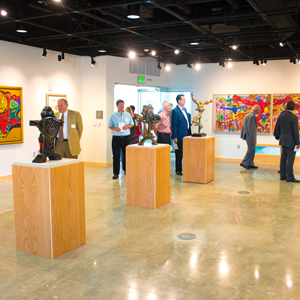Philanthropy at Work: Shirley and Vincent Fulginiti
Recent advances in health care technology and practice—combined with timeless questions about how health professionals interact with those they seek to heal—suggest the need for an ongoing dialogue regarding the increasingly complex role of ethics in the health sciences.
The Fulginiti Pavilion for Bioethics and Humanities is a philosophical home for the important marriage of ethics and humanities with the science of health care education, research and clinical care, as described by Vincent Fulginiti, chancellor emeritus of CU’s health sciences campus. This new Anschutz Medical Campus building was celebrated at an Aug. 27 reception, and it opened for the University of Colorado academic community this past week. The art gallery’s first exhibition, “Only Persist: Works by Ernst Neizvestney, from the collection of Wayne Yakes, M.D.,” opens today with a public reception from 5 to 8 p.m.
“There are larger issues involved in the art of medicine than just the science of medicine,” explains Vincent Fulginiti, who with his wife Shirley was fundamental in developing the vision and generating support for the Center for Bioethics and Humanities and the Fulginiti Pavilion’s construction. The $8 million in private gifts toward the building has included a generous personal contribution from the Fulginitis.
“Science is not enough in the practice of health. Practitioners also need to understand the holistic side of medicine, the ethical issues,” he says.
The discussions and research that the Pavilion facilitates will ensure not just a promising future for health care systems, but also a responsible and compassionate one.
When Vincent Fulginiti returned to CU in 1993 to become chancellor (he had an earlier faculty stint in the 1960s), it offered just one elective course on ethics in health science. With Fulginiti as a champion, the Center for Bioethics and Humanities has taken root and grown, such that all first-year health sciences doctoral students participate in ethics or humanities coursework.
In addition to the building’s focus on ethics, the Pavilion also features a concentration on arts and the humanities, unusual for an academic health sciences campus. A grand piano graces the first floor of the building, as does the aforementioned art gallery.
For Vincent and Shirley, the arts are a crucial component to a well-rounded health campus. “If this school was going to be truly well-rounded, we needed an Arts and Humanities Center,” says Fulginiti. “Also, arts provide stress relief for staff and faculty.”
The arts have been a constant in Vincent and Shirley’s life. On their first date, Vincent—then an intern at Philadelphia General Hospital—took Shirley (a nurse there) on a double-date to the opera. In a flower delivery van.
“The girls sat on crates in the back,” remembers Vincent, a former Colorado Symphony trustee, with a chuckle. “We had no money, but I had a friend with a flower delivery truck. Everyone else at the opera was in limos, and we pulled up in a flower truck.”
The Fulginitis have a come a long way since then, and the Pavilion that bears their name is only the latest in their list of proud contributions to the University of Colorado.
“We have felt the University of Colorado was good to us and has given us the opportunity to express our personal and professional lives,” says Vincent Fulginiti. “Many people don’t get that experience. We feel we need to give back. The school gave us something that’s priceless: the opportunity to express ourselves, and we’d like to acknowledge that. It’s also a way that we could leave a legacy, one that says, ‘Don’t forget humanities and ethics and the arts when you talk about your education.’ The building is just brick and mortar, but it stands for something more.”




